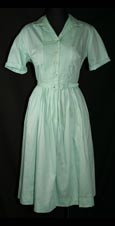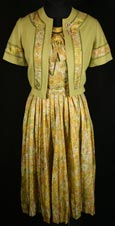Vintage Dresses Buyers Guide
Vintage dresses are one of the most popular destinations at VintageVixen.com. We offer 300-400 authentic vintage dresses any given time, with more arriving regularly. We think they're so popular because vintage dresses -- or any dress, for that matter -- provide an easy solution to the perennial question of 'What to wear?". There's no coordinating tops and bottoms, so a dress is a pretty simple wardrobe choice.In vintage dresses, along with the unique details and retro looks come variations you won't find in a modern clothing shop. First off, think of how you'd describe a dress... fitted, low-cut, straight, curvy, full-skirted... these are all descriptions of its silhouette, or outline. Most modern clothes have a fairly natural silhouette. And speaking of natural silhouettes, that brings us to the first twist in shopping vintage dresses...
Silhouettes Of Vintage Dresses

In the past, fashionistas wanted a silhouette (an outline of the body) that could be quite different from a natural figure. Depending on the latest designer creations, women might want to appear lean like Twiggy, flat-chested like a flapper, or bosomy as Sophia Loren.



Photos above show a variety of these silhouettes, including (from left) the A-line silhouette, the sheath, and the wasp-waist. Each was so de rigeur in their day that worldly women quickly modified their closets to match the latest silhouette from Paris.
Yet our bodies aren't that different from one fashion collection to the next, so women had to adapt their bodies to the currently fashionable silhouette. This was achieved with foundations, corsets, bustiers, padded bras (or binding of the chest as flappers did). We once even sold a vintage butt enhancer. Now that's a clever adaptation!
But for those who don't want to bother with such things, which dresses are easiest to wear without foundations?
- any casual dress, as it was more likely worn indoors without strict foundations
- ready-to-wear (because custom clothing was costly, and this kind of expensive vanity tended to over-emphasize a contrived silhouette)
- appropriate sizes - stick with misses, junior, petite or tall based on your figure
- dresses later in the 20th century, especially mid-1960s & later when fashion was once again created with natural silhouettes
These are generalizations but they provide a great start, and beyond this, you can always tell the silhouette of a dress online by its measurements (if not by its photo alone). A standard set of measurements for a given size will match our sizing chart for vintage clothing. So if you're a size 6 a natural silhouette will fit a 34-inch bust, 26-inch waist, and 36-inch hip.


| Problem | Solution | |
| If a vintage dress is too big: | all over | a too-big dress can be tailored down to your size |
| in bust | add bust darts, take up the side seams, and/or wear a padded bra | |
| at waist | slim the silhouette with vertical waist darts | |
| at hip | take up the side seams and/or lengthen the waist darts |
If it's too small, you have fewer options, but you can potentially let out seams. Be careful with specialty fabrics or formal fabrics like satin and taffeta, which could show the old line of stitching holes once it's let out. Remember to include ease in the final size. Also be aware that some ready-to-wear clothing has markers for the darts in the form of small holes, and if you let out a dart, it can expose these small holes. Check for this before you alter.
Most of our vintage dresses are effortlessly wearable, but a few require special care. We designate these dresses with a wearability recommendation like "wearable with due caution". To select dresses that can withstand regular carefree use, avoid things like:
- dresses with a description other than "wearable"
- thin or sheer silk
- pre-1950s dresses except those in cotton or wool
- items in good, fair or poor condition due to threadbare areas or patched holes
Depending on the style of dress, there are also many detailed tips specific to the types of vintage dresses we offer. Check out these links to learn your best bets in vintage dresses:
       |
Vintage Lounge Dresses Vintage Mini Dresses Vintage Shirtwaist Dresses Vintage Shift Dresses Vintage Sun Dresses Vintage Tailored Dresses Vintage Two-Piece Dresses
Back to Free Fashion History & Clothing Care Info
